SGS Thomson Microelectronics PSD511B1, PSD512B1, PSD513B1, PSD501B1, PSD502B1 Datasheet
...
PSD5XX
ZPSD5XX
Low Cost Field Programmable Microcontroller Peripherals
NOT FOR NEW DESIGN
FEATURES SUMMARY |
|
■ Single Supply Voltage: |
Figure 1. Packages |
– 5 V±10% for PSD5XX |
|
|
|
– 2.7 to 5.5 V for PSD5XX-V |
|
■ Up to 1 Mbit of UV EPROM |
|
■ Up to 16 Kbit SRAM |
|
■ Input Latches |
|
■ Programmable I/O ports |
|
■ Page Logic |
|
■ Programmable Security |
|
|
PLDCC68 (J) |
|
CLDCC68 (L) |
|
TQFP68 (U) |
|
|
January 2002 |
1/3 |
This is information on a product still in production but not recommended for new designs.

PSD5XX Family
PSD5XX/ZPSD5XX
Field-Programmable Microcontroller Peripherals
Table of Contents
1 |
Introduction ........................................................................................................................................................... |
1 |
||
2 |
Key Features ........................................................................................................................................................ |
3 |
||
3 |
Notation ................................................................................................................................................................ |
|
4 |
|
4 |
ZPSD Background ................................................................................................................................................ |
4 |
||
5 |
Integrated Power ManagementTM Operation ........................................................................................................ |
6 |
||
6 |
Design Flow .......................................................................................................................................................... |
7 |
||
7 |
PSD5XX Family .................................................................................................................................................... |
8 |
||
8 |
Table 2. PSD5XX Pin Descriptions...................................................................................................................... |
9 |
||
9 |
The PSD5XX Architecture .................................................................................................................................. |
11 |
||
|
9.1 |
The ZPLD Block.......................................................................................................................................... |
11 |
|
|
|
9.1.1 |
The DPLD......................................................................................................................................... |
14 |
|
|
9.1.2 |
The GPLD......................................................................................................................................... |
14 |
|
|
|
9.1.2.1 Por A Macrocell Structure .................................................................................................. |
16 |
|
|
|
9.1.2.2 Port B Macrocell Structure ................................................................................................. |
20 |
|
|
|
9.1.2.3 Port E Macrocell Structure ................................................................................................. |
23 |
|
|
9.1.3 |
The PPLD ......................................................................................................................................... |
26 |
|
|
9.1.4 The ZPLD Power Management ........................................................................................................ |
26 |
|
|
9.2 |
Bus Interface............................................................................................................................................... |
29 |
|
|
|
9.2.1 |
Bus Interface Configuration .............................................................................................................. |
29 |
|
|
9.2.2 PSD5XX Interface to a Multiplexed Bus ........................................................................................... |
29 |
|
|
|
9.2.3 PSD5XX Interface to Non-Multiplexed Bus ...................................................................................... |
30 |
|
|
|
9.2.4 |
Data Byte Enable.............................................................................................................................. |
30 |
|
|
9.2.5 |
Optional Features ............................................................................................................................. |
34 |
|
|
9.2.6 |
Bus Interface Examples.................................................................................................................... |
34 |
|
9.3 |
I/O Ports...................................................................................................................................................... |
39 |
|
|
|
9.3.1 |
Standard MCU I/O ............................................................................................................................ |
39 |
|
|
9.3.2 |
PLD I/O ........................................................................................................................................... |
39 |
|
|
9.3.3 |
Address Out...................................................................................................................................... |
40 |
|
|
9.3.4 |
Address In ........................................................................................................................................ |
40 |
|
|
9.3.5 |
Data Port .......................................................................................................................................... |
40 |
|
|
9.3.6 |
Special Function Out ........................................................................................................................ |
40 |
|
|
9.3.7 |
Alternate Function In ........................................................................................................................ |
41 |
|
|
9.3.8 |
Peripheral I/O ................................................................................................................................... |
41 |
|
|
9.3.9 |
Open Drain Outputs.......................................................................................................................... |
41 |
|
|
9.3.10 Port Registers................................................................................................................................... |
42 |
|
|
|
9.3.11 Port A – Functionality and Structure................................................................................................. |
45 |
|
|
|
9.3.12 Port B – Functionality and Structure................................................................................................. |
45 |
|
|
|
9.3.13 Port C and Port D – Functionality and Structure .............................................................................. |
48 |
|
|
|
9.3.14 Port E – Functionality and Structure................................................................................................. |
48 |
|
|
9.4 |
Memory Block ............................................................................................................................................. |
52 |
|
|
|
9.4.1 |
EPROM ............................................................................................................................................ |
52 |
|
|
9.4.2 |
SRAM ............................................................................................................................................... |
52 |
|
|
9.4.3 |
Memory Select Map.......................................................................................................................... |
52 |
|
|
9.4.4 Memory Select Map for 8031 Application......................................................................................... |
54 |
|
|
|
9.4.5 |
Peripheral I/O ................................................................................................................................... |
56 |
i

PSD5XX Family
PSD5XX/ZPSD5XX
Field-Programmable Microcontroller Peripherals
Table of Contents (cont.)
|
9.5 |
Power Management Unit ............................................................................................................................ |
58 |
||
|
|
9.5.1 |
Standby Mode .................................................................................................................................. |
58 |
|
|
|
9.5.2 |
Power Down ..................................................................................................................................... |
58 |
|
|
|
9.5.3 |
Sleep Mode ...................................................................................................................................... |
58 |
|
|
|
9.5.4 Other Power Saving Options ............................................................................................................ |
61 |
||
|
9.6 |
PSD5XX Counter/Timer .............................................................................................................................. |
63 |
||
|
|
9.6.1 |
Counter/Timer Operation.................................................................................................................. |
66 |
|
|
|
9.6.2 |
Counter/Timer Registers .................................................................................................................. |
81 |
|
|
9.7 |
Interrupt Controller ...................................................................................................................................... |
95 |
||
|
|
9.7.1 |
Interrupt Operation ........................................................................................................................... |
95 |
|
|
|
9.7.2 |
Input/Output.................................................................................................................................... |
100 |
|
|
|
9.7.3 |
PPLD Macrocell.............................................................................................................................. |
100 |
|
|
|
9.7.4 |
Interrupt Flowchart.......................................................................................................................... |
100 |
|
10.0 |
Page Register ................................................................................................................................................... |
103 |
|||
11.0 |
Security Protection............................................................................................................................................ |
103 |
|||
12.0 |
System Configuration ....................................................................................................................................... |
104 |
|||
|
12.1 |
|
Reset Input ............................................................................................................................................ |
108 |
|
|
12.2 |
|
ZPLD and Memory During Reset........................................................................................................... |
108 |
|
|
12.3 |
|
Register Values During and After Reset................................................................................................ |
108 |
|
|
12.4 |
|
ZPLD Macrocell Initialization ................................................................................................................. |
108 |
|
13.0 |
Specifications.................................................................................................................................................... |
109 |
|||
|
13.1 |
|
Absolute Maximum Ratings ................................................................................................................... |
109 |
|
|
13.2 |
|
Operating Range ................................................................................................................................... |
109 |
|
|
13.3 |
|
Recommended Operating Conditions.................................................................................................... |
109 |
|
|
13.4 |
|
AC/DC Parameters ................................................................................................................................ |
110 |
|
|
13.5 |
|
Example of PSD5XX Typical Power Calculation at VCC = 5.0 V ........................................................... |
111 |
|
|
13.6 |
|
DC Characteristics (5 V ± 10% versions) .............................................................................................. |
112 |
|
|
13.7 |
|
AC/DC Parameters – ZPLD Timing Parameters ................................................................................... |
113 |
|
|
13.8 |
|
Microcontroller Interface – AC/DC Parameters ..................................................................................... |
115 |
|
|
13.9 |
|
DC Characteristics (ZPSD5XXV Versions) (3.0 V ± 10% versions) ...................................................... |
120 |
|
|
13.10 |
AC/DC Parameters – ZPLD Timing Parameters (3.0 V ± 10% versions).............................................. |
121 |
||
|
13.11 |
Microcontroller Interface – AC/DC Parameters (3.0 V± 10% versions)................................................. |
121 |
||
14.0 |
Timing Diagrams............................................................................................................................................... |
128 |
|||
15.0 |
Pin Capacitance................................................................................................................................................ |
134 |
|||
16.0 |
AC Testing |
........................................................................................................................................................ |
134 |
||
17.0 |
Erasure and Programming................................................................................................................................ |
134 |
|||
18.0 |
PSD5XX Pin Assignments................................................................................................................................ |
135 |
|||
19.0 |
Package Information......................................................................................................................................... |
137 |
|||
20.0 |
PSD5XX Product Ordering Information ............................................................................................................ |
142 |
|||
|
20.1 |
|
PSD5XX Family – Selector Guide ......................................................................................................... |
142 |
|
|
20.2 |
|
Part Number Construction ..................................................................................................................... |
143 |
|
|
20.3 |
|
Ordering Information.............................................................................................................................. |
143 |
|
21.0 |
Process Change Notice, October 1, 1998 ........................................................................................................ |
148 |
|||
ii

|
|
|
|
|
|
|
Programmable Peripheral |
||
|
|
PSD5XX Family |
||
|
|
Field-Programmable Microcontroller Peripherals |
||
|
|
|
|
|
1.0 |
|
The PSD5XX family is a microcontroller peripheral that integrates high-performance and |
||
Introduction |
|
user-configurable blocks of EPROM, programmable logic, and SRAM into one part. The |
||
|
|
PSD5XX is also loaded with a variety of features, such as Counter/Timers, Interrupt |
||
|
|
controller, power management, and page logic. The PSD5XX products also provide a |
||
|
|
powerful microcontroller interface that eliminates the need for external “glue logic”. The no |
||
|
|
“glue logic” concept provides a user-programmable interface to a variety of 8- and 16-bit |
||
|
|
(multiplexed or non-multiplexed) microcontrollers that is easy to use. The part’s integration, |
||
|
|
small form factor, low power consumption, and ease of use make it the ideal part for |
||
|
|
interfacing to virtually any microcontroller. |
||
|
|
The PSD5XX provides three Zero-power PLDs (ZPLDs): a Decode PLD (DPLD), a |
||
|
|
General-purpose PLD (PLD), and a Peripheral PLD (PPLD). The ZPLDs have a total of 61 |
||
|
|
inputs, 140 product terms, 30 macrocells, and 24 I/O connections. A configuration bit |
||
|
|
(Turbo) can be set by the MCU, and will automatically place the ZPLDs into standby if |
||
|
|
no inputs are changing. The ZPLDs are designed to consume minimum power using Zero |
||
|
|
Power CMOS technology that uses low standby current. Unused product terms are |
||
|
|
automatically disabled, also reducing power, regardless of the Turbo bit setting. |
||
|
|
|
|
|
|
|
|
|
|
The main function of the DPLD is to perform address decoding for the internal I/O ports, EPROM, and SRAM. The address decoding can be based on up to 24 bits of address inputs, control signals (RD, WR, PSEN, etc.), and internal page logic. The DPLD supports separate program and data spaces (for 8031 compatible MCUs).
The General-purpose PLD (GPLD) can be used to implement various logic defined by the user, such as:
•State machines
•Loadable counters and shift registers
•Inter-processor mailbox
•External control logic (chip selects, output enables, etc.).
The GPLD has access to up to 61 inputs, 118 product terms, 24 macrocells, and 24 I/O pins.
1

PSD5XX Family
Introduction |
The Peripheral PLD (PPLD) generates outputs to the Counter/Timer unit and the Interrupt |
(cont.) |
Controller. The PPLD outputs to the Counter/Timer enable, disable, or trigger counting or |
|
time capture. The PPLD outputs to the Interrupt Controller enables the user to define |
|
conditions for interrupt generation. |
|
The Counter/Timer unit provides four 16-bit highly flexible Counter/Timers. Each has five |
|
modes of operation: pulse, waveform, event counting, time capture, and watchdog |
|
(real-time clock). Each Counter/Timer can be programmed to count up or down. The inputs |
|
to the Counter/Timer, which enable/disable counting or trigger an operation, can originate |
|
from the PPLD directly or directly from the pins. The maximum operating frequency of each |
|
counter is 7.5 MHz. The input clock can be divided (by up to 280) before driving the |
|
Counter/Timer unit using the 4 to 280 prescaler. |
|
The Interrupt Controller has eight levels of priority encoding. It accepts four user-defined |
|
interrupts and four terminal counts from the Counter/Timer. Each interrupt can be |
|
individually masked and configured to be level or edge sensitive. A 3-bit interrupt vector is |
|
generated that can be read by the microcontroller. The serviced interrupt will be cleared |
|
automatically after the microcontroller has read the interrupt vector. |
The PSD5XX has 40 I/O pins that are divided among 5 ports. Each I/O pin can be individually configured to provide many functions, including the following:
•MCU I/O
•ZPLD I/O
•Latched address output (for MCUs with multiplexed data bus)
•Special function I/O (Counter/Timer and Interrupts)
•Data bus (for MCUs with non-multiplexed data bus).
The PSD5XX can easily interface with virtually any 8- or 16-bit microcontroller with a multiplexed or non-multiplexed bus. All of the MCU control signals are connected to the ZPLDs, enabling the user to generate signals for external devices. The PSD5XX can generate a reset output based on the RESET input (includes hysteresis).
The PSD5XX provides between 256 Kbits and 1 Mbit of EPROM that is divided in to four equal-sized blocks. Each block can occupy a different address location, allowing for versatile address mapping. The access time of the EPROM includes the address latching and DPLD decoding.
The PSD5XX has an optional 16 Kbit SRAM that can be battery-backed by connecting a battery to the Vstby pin. The battery will protect the contents of the SRAM in the event of a power failure. Therefore, you can place data in the optional SRAM that you want to keep after the power is switched off. Power switch-over to the battery automatically occurs when Vcc drops below Vstby.
A four-bit Page Register enables easy access to the I/O section, EPROM, and SRAM for microcontrollers with limited address space. The Page Register outputs are connected to the ZPLDs and thus can also be used for external paging schemes.
Please refer to the revision block at the end of this document for updated information.
2

|
PSD5XX Family |
Introduction |
The Power Management Unit (PMU) of the PSD5XX enables the user to control the |
(cont.) |
power consumption on selected functional blocks, based on system requirements. For |
|
microcontrollers that do not generate a chip select input for the PSD, the Automatic |
|
Power-Down (APD) unit of the PMU can be setup to enable the PSD to enter Power Down |
|
or Sleep Mode, based on the inactivity of ALE (or AS). |
|
Implementing your design has never been easier than with PSDsoft—WSI’s software |
|
development suite. Using PSDsoft, you can do the following: |
|
• Configure your PSD5XX to work with virtually any microcontroller |
|
• Specify what you want implemented in the programmable logic using a design file |
|
• Simulate your design |
|
• Download your design to the part using a programmer. |
2.0Single-chip programmable peripheral for microcontroller-based applications
Key Features
256K to 1 Mbit of UV EPROM with the following features:
• Configurable as 32, 64, or 128 K x 8; or as 16, 32, or 64 K x 16
• Divided into four equally-sized mappable blocks for optimized address mapping
• As fast as 70 ns access time, which includes address decoding
• Built-in Zero-power technology
16 Kbits SRAM is configurable as 2K x 8 or 1K x 16. The access time can be
as quick as 70 ns, including address decoding. The contents of the SRAM can be battery-backed by connecting a battery to the Vstby pin. The SRAM was also designed using Zero-power technology
40 I/O pins (divided into five 8-bit ports) that can be individually configured for:
• Standard MCU I/O
• PLD/macrocell I/O
• Latched address output
• High-order address inputs
• Special function I/O
• Open-drain output
Three Zero-power Programmable Logic Devices (ZPLDs): the Decode PLD (DPLD), the General-purpose PLD (GPLD), and the Peripheral PLD (PPLD) can be used for:
• Up to 61 input and 140 output product terms
• 24 Macrocells and I/O
• Decode up to 16 MB of address
• State machines and state logic
• Generate external signals (chip selects, bus interface, etc.)
Microcontroller logic that eliminates the need for external “glue logic” has the following features:
• Ability to interface to multiplexed and non-multiplexed buses
• Built-in address latches for multiplexed address/data bus
• ALE and Reset polarity are programmable
• Multiple configurations are possible for interface to many different microcontrollers
Four 16-bit Counter/Timers that have five modes of operation and can be controlled by the PPLD macrocells. Modes of operation are: pulse and waveform generation, time capture, event counting, and a watchdog timer (real time clock).
Eight input priority encoded Interrupt Controller. Four interrupts are generated by the PPLD and are user defined. The other four interrupts are generated by the Counter/Timer’s terminal count flags. Each interrupt can be individually masked and configured as edge or level sensitive.
Page logic is connected to the ZPLDs and expands the MCU address space to up to 16 times
3

PSD5XX Family
Key Features |
Programmable power management allows: |
|
(cont.) |
• |
SRAM, EPROM, and ZPLDs to enter standby mode automatically |
|
• |
Disabling of the clock input to the ZPLDs |
|
• |
ZPLDs to enter a special low power mode (Sleep Mode), based on Turbo bit setting |
A security bit prevents reading the PSD5XX configuration and the ZPLD contents. Setting this bit will prevent the device from being copied on a device programmer.
Built-in security enables the user to block read accesses from a device programmer
Package choices include a 68-pin PLCC and CLDCC, and an 80-pin TQFP.
Programmable polarity Reset output (includes hysteresis), based on Reset input
Simple, menu-driven software (PSDsoft) allows configuration and design entry on a PC.
3.0 Notation
Throughout this data sheet, references are made to the PSD5XX. In most cases, these references also cover the ZPSD5XX and ZPSD5XXV products. Exceptions will be noted.
The main difference between the ZPSD5XX and the PSD5XX is the standby current (Isb). The ZPSD5XX devices have been rated for a lower standby current. Also, there is no low-voltage version of the PSD5XX. There is only the low-voltage version of the ZPSD5XX, which has a V suffix.
4.0 ZPSD
Background
Portable and battery powered systems have recently become major embedded control application segments. As a result, the demand for electronic components having extremely low power consumption has increased dramatically. Recognizing this need, WSI, Inc.
has developed a new Zero-Power technology. ZPSD products virtually eliminate the DC component of power consumption reducing it to standby levels. Eliminating the DC component is the basis for the words “Zero Power”. ZPSD products also minimize the AC power component when the chip is changing states. The result is a programmable microcontroller peripheral family that replaces discrete circuit functions while drawing minimal power.
4
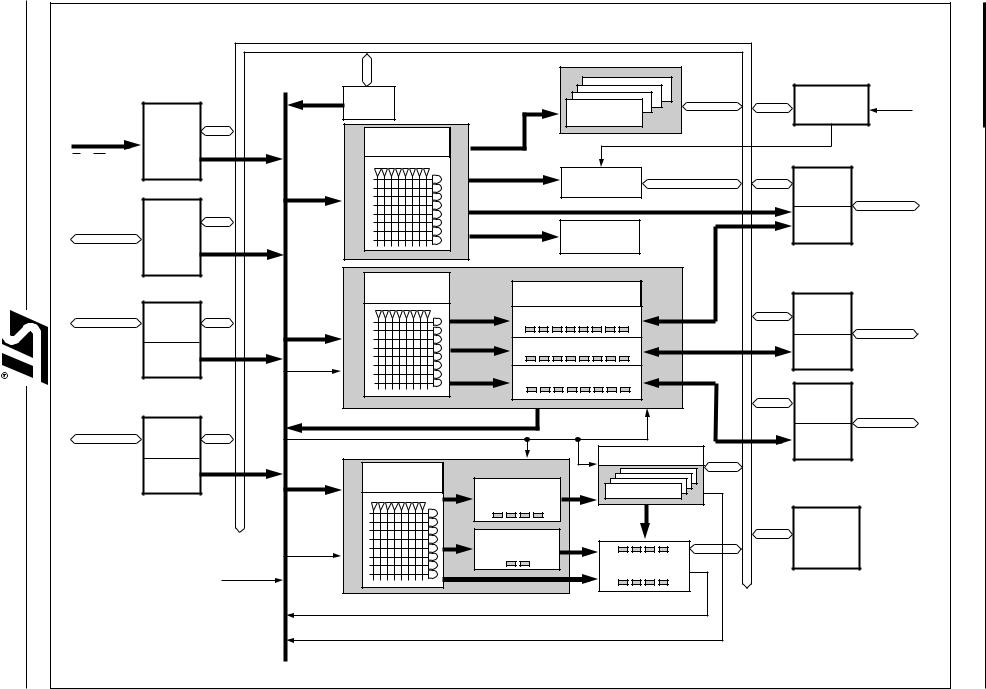
CONTROL
RD, WR
AD0 – AD15
PC0 – PC7
PD0 – PD7
5
|
|
ADDRESS/DATA/CONTROL BUS |
|
|
|
|
ZPLD |
|
|
|
|
|
|
INPUT |
|
|
|
|
|
|
BUS |
|
|
|
POWER |
|
|
|
PAGE |
|
|
|
VSTDBY |
|
|
|
256K – 1M BIT |
MANAGER |
|||
|
REG. |
|
|
|||
|
|
EPROM |
UNIT |
|
|
|
|
|
EPROM |
|
|
||
PROG. |
DECODE PLD |
|
|
|
|
|
SELECT |
|
|
|
|
||
BUS |
(DPLD) |
|
|
|
|
|
INTRF |
|
SRAM |
|
|
|
|
|
|
SELECT |
16 K BITS |
PROG. |
|
|
|
|
|
|
|
||
61 |
|
PERIPHERAL |
SRAM |
PA0 – PA7 |
||
|
PORT |
|||||
|
|
SELECTS |
|
|
|
|
|
|
CSIOP |
|
PORT |
|
|
ADIO |
|
I/O |
A |
|
|
|
PORT |
|
|
DECODER |
|
|
|
|
GENERAL PLD |
24 MACROCELLS |
|
|
|
|
(GPLD) |
|
|
||
PROG. |
27PT |
PORT A MACROCELLS |
PROG. |
|
|
PORT |
PB0 – PB7 |
||||
60 |
|||||
PORT |
|
|
|
||
PORT |
80PT |
PORT B MACROCELLS |
PORT |
|
|
CLKIN |
|
B |
|
||
C |
|
|
|||
|
|
|
|||
|
11PT |
PORT E MACROCELLS |
|
|
|
|
|
|
|
||
|
|
|
PROG. |
|
|
|
MACROCELL FEEDBACK OR PORT INPUT |
PORT |
PE0 – PE7 |
||
|
|
|
|||
PROG. |
|
CLKIN |
PORT |
|
|
PORT |
|
COUNTER/TIMERS |
E |
|
|
|
|
|
|
||
PORT |
|
PERIPHERAL |
|
|
|
|
D |
60 |
|
|
|
|
|
PLD (PPLD) |
8PT |
4 |
FOUR 16 - BIT |
|
||
|
|
|
|
MACROCELLS |
|
|
|
|
|
|
|
|
|
|
|
|
|
|
TERMINAL |
GLOBAL |
|
|
|
|
|
COUNTS |
|
|
|
|
4PT |
|
CONFIG. |
|
|
|
|
2 |
|
||
|
CLKIN |
|
|
|
& |
|
|
|
|
MACROCELLS |
|
||
|
|
|
INTERRUPT |
SECURITY |
||
|
|
|
|
|
||
|
|
|
2PT |
|
|
|
CLKIN |
|
|
|
CONTROLLER |
|
|
|
|
|
|
|
||
|
|
|
|
|
|
|
|
|
|
|
INTERRUPT OUTPUT |
|
|
|
|
|
WATCH DOG OUTPUT |
|
|
|
Diagram Block PSD5XX .1 Figure
Family PSD5XX

PSD5XX Family
5.0 Integrated Power Management TM Operation
Upon each address or logic input change to the PSD, the device powers up from low power standby for a short time. Then the PSD consumes only the necessary power to deliver new logic or memory data to its outputs as a response to the input change. After the new outputs are stable, the PSD latches them and automatically reverts back to standby mode. The ICC current flowing during standby mode and during DC operation is identical.
The PSD automatically reduces its DC current drain to these low levels and does not require controlling by the CSI (Chip Select) input. Disabling the CSI pin unconditionally forces the PSD to standby mode independent of other input transitions.
The only significant power consumption in the PSD occurs during AC operation.
The PSD contains the first architecture to apply Zero-power techniques to memory circuit blocks as well as logic.
Figure 2 compares PSD Zero-power operation to the operation of a discrete solution.
A standard microcontroller (MCU) bus cycle usually starts with an ALE (or AS) pulse and the generation of an address. The PSD detects the address transition and powers up for a short time. The PSD then latches the outputs of the PAD, EPROM and SRAM to the new values. After finishing these operations, the PSD shuts off its internal power, entering standby mode. The time taken for the entire cycle is less than the PSD’s “access time.”
The PSD will stay in standby mode if the inputs do not change between bus cycles. In an alternate system implementation using discrete EPROM, SRAM and other discrete components, the system will consume operating power during the entire bus cycle. This is because the chip select inputs on the memory devices are usually active throughout the entire cycle. The AC power consumption of the PSD may be calculated using the composite frequency of the MCU address and control inputs, as well as any other logic inputs to the ZPLD.
NOTE: The ZPSD5XX parts have been rated for a lower standby current (ISB) than the PSD5XX parts.
Figure 2. ZPSD Power Operation vs. Discrete Implementation
ALE |
|
|
|
|
ADDRESS |
EPROM |
SRAM |
EPROM |
|
ACCESS |
ACCESS |
ACCESS |
||
|
||||
DISCRETE EPROM, SRAM & LOGIC |
|
|
||
ICC |
ZPSD |
ZPSD |
ZPSD |
|
|
|
|||
|
|
TIME |
|
|
6
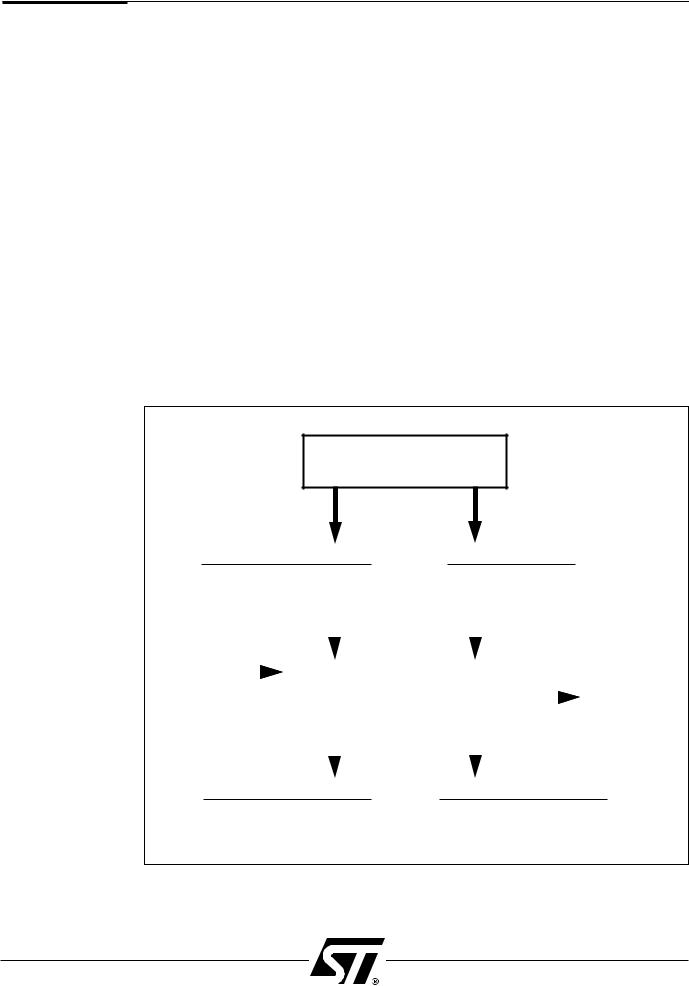
PSD5XX Family
6.0
Design Flow
Shown in Figure 3 (below) is the software design flow for a PSD5XX device.
PSDsoft—WSI’s software development suite—is used throughout the design phase. You start with a design file that is written in PSDabel-a high-level hardware description language (HDL). Before you compile your design, you must also configure the PSD5XX so it knows what signals to expect from your microprocessor and what pre-runtime options should be set (such as the security bit).
Once you have a design file and have configured the device, you are ready to run the Fitter and Address Translator. The Fitter accepts input from PSDabel and PSD Configuration, synthesizes this user logic and configuration, and fits the design to the PSD silicon.
The Address Translator process allows the user to map the MCU firmware from a cross-compiler (in Intel HEX or S-Record format) into the NVM memory blocks within the PSD. As a result, the MCU firmware is merged with the logic and configuration definition of the PSD.
The output of the Address Translator and the Fitter is the required object file that is used by a programmer to program the PSD device. The object file includes chip configuration, the PLD fusemap, and MCU firmware information.
PSDsilosIII is an optional program that provides functional chip-level simulation of the PSD5XX. PSDsoft automatically creates files for input to the simulator. These files convey relevant design information to the simulator. As a result, the user only has to create a stimulus file since all of the signals and node names are taken from the design file.
Figure 3. PSDsoft Development Tools
PSDsoft
Development Software
PSDabel™ |
|
PSD Configuration |
||||
ZPLD DESCRIPTION |
|
CHIP CONFIGURATION |
||||
(STATE MACHINE, DECODING) |
|
|||||
|
|
|
|
|||
|
|
|
|
|
|
|
|
|
|
|
|
|
|
|
|
|
|
|
|
|
CODE FILE |
|
|
|
|
PSD Compiler |
|
THIRD PARTY |
||
|
|
|
|
||||||
|
|
|
|
||||||
|
|
|
|
|
|
||||
|
|
|
(ZPLD FITTING, ADDRESS TRANSLATION) |
|
|||||
|
|
|
|
PROGRAMMERS |
|||||
|
|
|
|
|
|
|
|
|
|
|
|
|
|
|
|
|
|
|
|
|
|
|
|
|
|
|
|
|
|
PSDsilos III™ |
|
PSD Programmer |
SILOSIII |
|
PSDpro/MagicPro® |
CHIP SIMULATION |
|
CHIP PROGRAMMING |
|
|
|
7

PSD5XX Family
7.0 |
There are 7 unique devices in the PSD5XX family. The part classifications are based on |
||||||||||||
PSD5XX |
EPROM size and data bus width. The features of each part are listed in Table 1. |
|
|||||||||||
Family |
|
|
|
|
|
|
|
|
|
|
|
|
|
|
Table 1. PSD5XX Product Matrix |
|
|
|
|
|
|
|
|
||||
|
|
|
|
|
|
|
|
|
|
|
|
|
|
|
Part |
Bus |
DPLD + GPLD + PPLD |
|
I/O |
Timers |
Inter. |
WD* |
PMU |
EPROM |
SRAM |
||
|
Inputs |
Product |
Registered |
|
|||||||||
|
# |
Bit |
|
Pins |
|
Contr. |
|
|
K bit |
K bit |
|||
|
|
|
|
Terms |
Macrocells |
|
|
|
|
|
|
|
|
|
501B1 |
x8/x16 |
61 |
140 |
30 |
40 |
4 * 16 |
8 |
1 * 16 |
Yes |
256 |
16 |
|
|
511B1 |
x8 |
61 |
140 |
30 |
40 |
4 * 16 |
8 |
1 * 16 |
Yes |
256 |
16 |
|
|
502B1 |
x8/x16 |
61 |
140 |
30 |
40 |
4 * 16 |
8 |
1 * 16 |
Yes |
512 |
16 |
|
|
512B0 |
x8 |
61 |
140 |
30 |
40 |
4 * 16 |
8 |
1 * 16 |
Yes |
512 |
– |
|
|
512B1 |
x8 |
61 |
140 |
30 |
40 |
4 * 16 |
8 |
1 * 16 |
Yes |
512 |
16 |
|
|
503B1 |
x8/x16 |
61 |
140 |
30 |
40 |
4 * 16 |
8 |
1 * 16 |
Yes |
1024 |
16 |
|
|
513B1 |
x8 |
61 |
140 |
30 |
40 |
4 * 16 |
8 |
1 * 16 |
Yes |
1024 |
16 |
|
WD = WatchDog Timer.
PMU = Power Management Unit.
*One of the four 16-Bit Timers.
8

PSD5XX Family
8.0 Table 2.
PSD5XX Pin Descriptions
The following table describes the pin names and pin functions of the PSD5XX. Pins that have multiple names and/or functions are defined by user configuration.
Pin Name |
Pin Function |
Type |
|
Function Descriptions |
|||||
|
|
|
|
|
|
|
|
|
|
ADIO0 – ADIO15 |
Address/ data bus |
I/O |
1. Address/data bus, multiplexed |
||||||
|
|
|
|
|
|
|
|
|
bus mode |
|
|
|
|
|
|
|
|
2. |
Address bus, non-multiplexed |
|
|
|
|
|
|
|
|
|
bus mode |
|
|
|
|
|
|
|
|
|
|
RD |
Multiple Names |
I |
Multiple functions |
||||||
|
1. Read |
|
1. |
Read signal |
|||||
|
2. E |
|
2. |
E signal (Clock) |
|||||
|
3. |
|
DS |
|
|
|
|
3. |
Data strobe signal |
|
4. |
|
LDS |
|
|
|
4. |
Low byte data strobe |
|
|
|
|
|
|
|
||||
WR |
Multiple Names |
I |
Multiple functions |
||||||
|
1. WR |
|
1. |
Write signal |
|||||
|
2. R/W |
|
2. |
Read-write signal |
|||||
|
3. |
WRL |
|
|
3. |
Low byte write signal |
|||
|
|
|
|
||||||
CSI |
Chip Select Input |
I |
Active low, select PSD5XX. |
||||||
|
|
|
|
|
|
|
|
standby mode if high. |
|
|
|
|
|
||||||
RESET |
Reset Input |
I |
Reset I/O ports, ZPLD/macrocells, |
||||||
|
|
|
|
|
|
|
|
Timers and Configuration |
|
|
|
|
|
|
|
|
|
Registers. Active low. |
|
|
|
|
|
||||||
CLKIN |
Input clock |
I |
Clock input to Timers, ZPLD |
||||||
|
|
|
|
|
|
|
|
macrocells, ZPLD array, and APD |
|
|
|
|
|
|
|
|
|
counter; connect to ground if clock |
|
|
|
|
|
|
|
|
|
input not used. |
|
|
|
|
|
||||||
PA0 – PA7 |
I/O Port A |
I/O |
Multiple functions |
||||||
|
|
|
|
|
|
|
|
1. |
I/O port |
|
|
|
|
|
|
|
|
2. |
ZPLD/macrocell I/O port |
|
|
|
|
|
|
|
|
3. |
Latched address outputs |
|
|
|
|
|
|
|
|
|
(PA0–PA7) → (A0–A7) |
|
|
|
|
|
|
|
|
4. |
High address inputs (A16 – A23) |
|
|
|
|
|
|
|
|
5. |
Timer outputs (PA0 – PA3) |
|
|
|
|
||||||
PB0 – PB7 |
I/O Port B |
I/O |
Multiple functions |
||||||
|
|
|
|
|
|
|
|
1. |
I/O port |
|
|
|
|
|
|
|
|
2. |
ZPLD/macrocell I/O port |
|
|
|
|
|
|
|
|
3. |
Latched address outputs |
|
|
|
|
|
|
|
|
|
(PB0–PB7) → (A0–A7) or (A8–A15) |
|
|
|
|
|
|
|
|
4. |
Timer outputs (PB0-PB3) |
|
|
|
|
||||||
PC0 – PC7 |
I/O Port C |
I/O |
Multiple functions |
||||||
|
|
|
|
|
|
|
CMOS |
1. |
I/O port |
|
|
|
|
|
|
|
or |
2. |
ZPLD input port |
|
|
|
|
|
|
|
OD |
3. |
Latched address outputs |
|
|
|
|
|
|
|
|
|
(PC0 – PC7) → (A0–A7) |
|
|
|
|
|
|
|
|
4. |
Data Port (D0 – D7, |
|
|
|
|
|
|
|
|
|
non-multiplexed bus) |
|
|
|
|
||||||
PD0 – PD7 |
I/O Port D |
I/O |
Multiple functions |
||||||
|
|
|
|
|
|
|
CMOS |
1. |
I/O port |
|
|
|
|
|
|
|
or |
2. |
ZPLD input port |
|
|
|
|
|
|
|
OD |
3. |
Latched address outputs |
|
|
|
|
|
|
|
|
|
(PD0–PD7) → (A0–A7) or (A8–A15) |
|
|
|
|
|
|
|
|
4. |
Data Port (D8-D15, |
|
|
|
|
|
|
|
|
|
non-multiplexed bus) |
|
|
|
|
|
|
|
|
|
|
9

PSD5XX Family
Table 2.
PSD5XX Pin
Descriptions
(Cont.)
Pin Name |
|
Pin Function |
Type |
|
Function Descriptions |
|
|
|
|
|
|
||
PE0 |
Port PE, pin 0 |
I/O |
Multiple functions |
|||
|
1. |
BHE |
|
1. |
High byte enable, 16 bit data |
|
|
2. |
PSEN |
|
|
2. |
Read program memory, 8031 signal |
|
3. |
WRH |
|
|
write high data byte |
|
|
4. |
UDS |
|
4. |
Upper Data Strobe |
|
|
5. |
SIZ0 |
|
5. |
Byte enable, 68300 signal |
|
|
6. |
PE0 |
|
6. |
I/O pin |
|
|
7. |
PE0 |
|
7. |
ZPLD I/O pin |
|
|
8. |
PE0 |
|
8. |
Latched Address Out – A0 |
|
|
|
|
|
|
||
PE1 |
Port PE, pin 1 |
I/O |
Multiple functions |
|||
|
1. |
ALE |
|
1. |
Address strobe |
|
|
2. |
PE1 |
|
2. |
I/O pin |
|
|
3. |
PE1 |
|
3. |
ZPLD I/O pin |
|
|
4. |
PE1 |
|
4. |
Latched Address Out – A1 |
|
|
|
|
|
|
||
PE2 |
Port PE, pin 2 |
|
Multiple functions |
|||
|
1. |
Intr Out |
|
1. |
Interrupt Controller Output |
|
|
2. |
PE2 |
I/O |
2. I/O pin |
||
|
3. |
PE2 |
|
3. |
ZPLD I/O pin |
|
|
4. |
PE2 |
|
4. |
Latched Address Out – A2 |
|
|
|
|
|
|
||
PE3 |
Port PE, pin 3 |
|
Multiple functions |
|||
|
1. |
Timer0-In |
|
1. |
Timer0 control input |
|
|
2. |
PE3 |
I/O |
2. I/O pin |
||
|
3. |
PE3 |
|
3. |
ZPLD I/O pin |
|
|
4. |
PE3 |
|
4. |
Latched Address Out – A3 |
|
|
|
|
|
|
||
PE4 |
Port PE, pin 4 |
|
Multiple functions |
|||
|
1. |
Timer1-In |
|
1. |
Timer1 control input |
|
|
2. |
PE4 |
I/O |
2. I/O pin |
||
|
3. |
PE4 |
|
3. |
ZPLD I/O pin |
|
|
4. |
PE4 |
|
4. |
Latched Address Out – A4 |
|
|
5. |
TC0 |
|
5. |
Timer0 Terminal Count |
|
|
|
|
|
|
||
PE5 |
Port PE, pin 5 |
|
Multiple functions |
|||
|
1. |
Timer2-In |
|
1. |
Timer2 control input |
|
|
2. |
PE5 |
I/O |
2. I/O pin |
||
|
3. |
PE5 |
|
3. |
ZPLD I/O pin |
|
|
4. |
PE5 |
|
4. |
Latched Address Out – A5 |
|
|
5. |
TC1 |
|
5. |
Timer1 Terminal Count |
|
|
|
|
|
|
||
PE6 |
Port PE, pin 6 |
|
Multiple functions |
|||
|
1. |
Timer3-In |
|
1. |
Timer3 control input |
|
|
2. |
PE6 |
I/O |
2. I/O pin |
||
|
3. |
PE6 |
|
3. |
ZPLD I/O pin |
|
|
4. |
PE6 |
|
4. |
Latched Address Out – A6 |
|
|
5. |
TC2 |
|
5. |
Timer2 Terminal Count |
|
|
|
|
|
|
||
PE7 |
Port PE, pin 7 |
|
Multiple functions |
|||
|
1. |
APD CLK |
|
1. |
Automatic Power Down Clock Input |
|
|
2. |
PE7 |
I/O |
2. I/O pin |
||
|
3. |
PE7 |
|
3. |
ZPLD I/O pin |
|
|
4. |
PE7 |
|
4. |
Latched Address Out – A7 |
|
|
5. |
TC3 |
|
5. |
Timer3 Terminal Count |
|
|
|
|
|
|
||
VSTBY |
VSTBY |
I |
SRAM power pin for standby |
|||
|
|
|
|
operation (battery backup) |
||
|
|
|
|
|
||
|
|
|
|
|
||
VCC |
VCC |
I |
Chip VCC power pin |
|||
GND |
GND |
I |
Chip ground pin |
|||
|
|
|
|
|
|
|
10

PSD5XX Family
9.0
The PSD5XX Architecture
PSD5XX consists of seven major functional blocks:
ZPLD Blocks
Bus Interface
I/O Ports
Memory Block
Power Management Unit
Counter/Timer
Interrupt Controller
The functions of each block are described in the following sections. Many of the blocks perform multiple functions, and are user configurable. The chip configurations are specified by the user in the PSDsoft Development Software; some are specified by setting up the appropriate bits in the configuration registers during run time.
9.1 ZPLD Block
Key Features
3 Embedded ZPLD devices
Maximum 30 macrocells
Combinatorial/registered outputs
Maximum 140 product terms
Programmable output polarity
User configured register clear/preset
User configured register clock input
61 Inputs
Accessible via 24 I/O pins
Power Saving Mode
UV-Erasable
Generate user defined interrupts to Interrupt Controller and controls to Counter/Timer
General Description
The ZPLD block has 3 embedded PLD devices:
DPLD
The Address Decoding PLD, generating select signals to internal I/O or memory blocks.
GPLD
The General Purpose PLD provides 24 programmable macrocells for general or complex logic implementation; dedicated to user application.
PPLD
The Peripheral PLD, includes 6 programmable macrocells. The PPLD provides control to the operation of the Counter/Timer and Interrupt Controller.
Figure 4 shows the architecture of the ZPLD. The PLD devices all share the same input bus. The true or complement of the 61 input signals are fed to the programmable
AND-ARRAY. Names and source of the input signals are shown in Table 3. The PA, PB, PE signals, depending on user configuration, can either be macrocell feedbacks or inputs from Port A, B or E.
11

12
ZPLD INPUT
|
|
BUS |
ES0 – ES3 |
|
|
|
DPLD |
PAGE |
PGR0 – 3 |
DPLD |
RS0 |
|
|
|
|
REG. |
|
CSIOP |
|
|
|
(DECODING PLD) |
|
|
|
|
PSEL0 – PSEL1 |
|
|
||
|
|
|
|
|
|
||
ADIO |
A8 – A15 |
|
27 PT |
8 I/O |
|
PROG. |
|
PORT |
A0, A1 |
AND |
PA0 – PA7 |
PORT |
|
||
|
|
|
MACROCELLS |
|
PORT |
|
|
|
|
ARRAY |
|
PA |
|
|
|
PROG. |
|
|
|
|
|
A |
|
PC0 – PC7 |
|
|
|
|
|
|
|
PORT |
|
|
|
|
|
GPLD |
|
PORT |
|
|
80 PT |
8 I/O |
|
PROG. |
|
|
|
|
(GENERAL |
||||
C |
|
AND |
PB0 – PB7 |
PORT |
|||
|
|
MACROCELLS |
|||||
|
|
|
PORT |
PURPOSE PLD) |
|||
|
|
ARRAY |
|
PB |
|
||
|
|
|
|
|
|||
PROG. |
|
|
|
|
|
B |
|
PD0 – PD7 |
|
|
|
|
|
|
|
PORT |
|
|
|
|
|
|
|
PORT |
|
|
11 PT |
8 I/O |
PE0 – PE7 |
PROG. |
|
|
|
PORT |
|
||||
D |
|
AND |
|
MACROCELLS |
|
||
|
|
|
|
|
|||
|
|
ARRAY |
|
PE |
|
PORT |
|
|
|
|
|
|
|
E |
|
PMU |
|
|
|
|
|
|
|
|
|
AND |
8 PT |
4 OUTPUT |
MC2TMR0 – 3 |
TIMERS |
|
CSI |
|
|
MACROCELLS |
|
|
||
|
ARRAY |
|
|
|
PPLD |
||
|
|
|
|
WDOG2PLD |
|
|
|
|
|
|
|
|
|
(PERIPHERAL PLD) |
|
RD/E/DS |
|
|
|
|
|
|
|
|
|
|
|
|
|
|
|
WR/R_W |
|
AND |
4 PT |
2 OUTPUT |
MC2INT6 – 7 |
INTR. |
|
RESET |
|
|
PT2INT4 – 5 |
|
|||
|
2 PT |
MACROCELLS |
CTRL |
|
|||
|
ARRAY |
|
|||||
|
|
|
|
|
|
|
|
CLKIN |
|
INTR2PLD |
|
|
|
|
|
|
|
|
|
|
|
|
|
PSD5XX The Architecture |
|
Family PSD5XX |
|
|
.4 Figure |
|
|
|
|
|
|
|
|
|
|
|
Diagram Block ZPLD |
|
|
|
|
|
|
|
|
|
|

PSD5XX Family
The PSD5XX |
Table 3. ZPLD Input Signals |
|
|
|
|
||
Architecture |
|
|
|
|
|
|
|
|
Signal Name |
|
From |
||||
(cont.) |
|
|
|||||
|
|
|
|
|
|
|
|
|
|
PA0 – PA7 |
|
Port A inputs or Macrocell PA feedback |
|||
|
|
|
|
|
|
|
|
|
|
PB0 – PB7 |
|
Port B inputs or Macrocell PB feedback |
|||
|
|
|
|
|
|
|
|
|
|
PE0 – PE7 |
|
Port E inputs or Macrocell PE feedback |
|||
|
|
|
|
|
|
|
|
|
|
PC0 – PC7 |
|
Port C inputs |
|||
|
|
|
|
|
|
|
|
|
|
PD0 - PD7 |
|
Port D inputs |
|||
|
|
|
|
|
|
|
|
|
|
PGR0 – PGR3 |
|
Page Mode Register |
|||
|
|
|
|
|
|
|
|
|
|
WDOG2PLD |
|
Counter/Timer |
|||
|
|
|
|
|
|
|
|
|
|
INTR2PLD |
|
Interrupt Controller |
|||
|
|
|
|
|
|
|
|
|
|
A8 – A15, A0, A1 |
|
MCU Address Lines |
|||
|
|
|
|
|
|
|
|
|
|
RD/E/DS |
|
MCU bus signal |
|||
|
|
|
|
|
|
|
|
|
|
WR/R_W |
|
MCU bus signal |
|||
|
|
|
|
|
|
|
|
|
|
CLKIN |
|
Input Clock |
|||
|
|
|
|
|
|
|
|
|
|
RESET |
|
Reset input |
|||
|
|
|
|
|
|
|
|
|
|
|
|
|
|
|
|
|
|
CSI |
|
CSI input (ORed with power down from PMU) |
|||
|
|
|
|
|
|
|
|
13

PSD5XX Family
The PSD5XX |
9.1.1 The DPLD |
Architecture |
The DPLD is used for internal address decoding generating the following eight |
|
chip select signals: |
|
ES0 – ES3 |
|
EPROM selects, block 0 to block 3 |
|
RS0 |
|
SRAM block select |
|
CSIOP |
|
I/O Decoder chip select |
|
PSEL0 – PSEL1 |
|
Peripheral I/O mode select signals |
|
The I/O Decoder enabled by the CSIOP generates chip selects for on-chip registers or I/O |
|
ports based on address inputs A[7:0]. |
|
As shown in Figure 5, the DPLD consists of a large programmable AND ARRAY. There are |
|
a total of 61 inputs and 8 outputs. Each output consists of a single product term. Although |
|
the user can generate select signals from any of the inputs, the select signals are typically a |
|
function of the address and Page Register inputs. The select signals, which are active High, |
|
are defined by the user in the ABEL file (PSDabel). |
|
The address line inputs to the DPLD include A0, A1 and A8 – A15. If more address lines |
|
are needed, the user can bring in the lines through Port A to the DPLD. |
9.1.2 The GPLD
The structure of the General Purpose PLD consists of a programmable AND ARRAY and 3 sets of I/O Macrocells. The ARRAY has 61 input signals, same as the DPLD. From these inputs, “ANDed” functions are generated as product term inputs to the macrocells. The I/O Macrocell sets are named after the I/O Ports they are linked to, e.g., the macrocells connected to Port A are named PA Macrocells. The 3 sets of macrocells, PA, PB and PE, are similar in structure and function.
Figure 6 shows the output/input path of a GPLD macrocell to the Port pin with which it is associated. If the Port pin is specified as a GPLD output pin in PSDsoft, the MUX in the I/O Port Cell selects the GPLD macrocell as an output of the Port pin. The output enable signal to the buffer in the I/O cell can be controlled by a product term from the AND ARRAY.
If the Port pin is specified as a ZPLD input pin, the MUX in the GPLD macrocell selects the Port input signal to be one of the 61 signals in the ZPLD Input Bus.
14
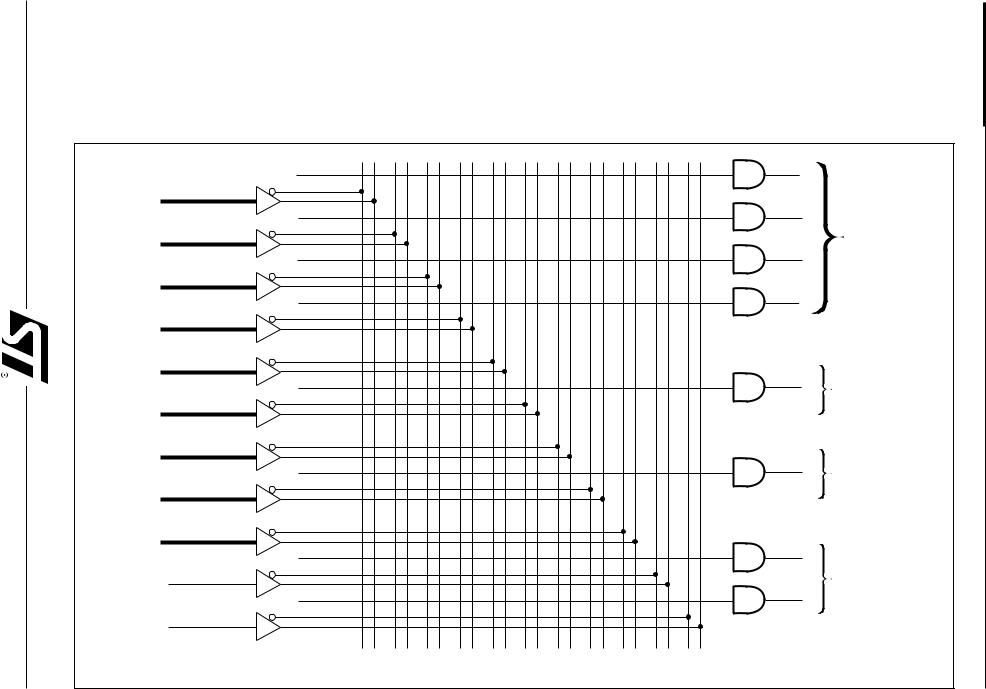
15
(INPUTS)
PA0 – PA7
(8)
PB0 – PB7
(8)
PE0 – PE7
(8)
PC0 – PC7
(8)
PD0 – PD7
(8)
PGR0 – PGR3
(4)
A8 – A15, A0, A1
(10)
WDOG2PLD
(2)
INTR2PLD
CSI, CLKIN
(3)
RESET
RD/E/DS
(1)
WR/R_W
(1)
DPLD INPUTS : 61
DPLD OUTPUTS : 8
ES0
ES1
ES2
ES3
RS0
CSIOP
PSEL0
PSEL1
4 EPROM BLOCK SELECTS
RAM SELECT
I/O DECODER SELECT
PERIPHERAL I/O SELECTS
Array Logic DPLD .5 Figure PSD5XX The Architecture ).(cont
Family PSD5XX

PSD5XX Family
The PSD5XX
Architecture
(cont.)
9.1.2.1 Port A Macrocell Structure
Figure 6a shows the PA Macrocell block, which consists of 8 identical macrocells. Each macrocell output can be connected to its own I/O pin on Port A. There are 3 user programmable global product terms output from the GPLD’s AND ARRAY which are shared by all the macrocells in Port A:
PA.OE
Enable or tri-state Port A output pins
PA.PR
Preset D flip flop in the macrocells
PA.RE
Reset/Clear D flip flop in the macrocells
Two other inputs, CLKIN and MACRO-RST, are used as clock and clear inputs to the D flip flop. The CLKIN comes directly from the CLKIN input pin. The MACRO-RST is the same as the Reset input pin except it is user configurable.
The circuit of a Port A Macrocell is shown in Figure 7. There are 6 product terms from the GPLD’s AND ARRAY as inputs to the macrocell. Users can select the polarity of the output, and configure the macrocell to operate as:
Registered Output
Select output from D flip flop
Combinatorial Output
Select output from OR gate
GPLD Input
Use Port A pin as dedicated input
GPLD Output
Use Port A pin as dedicated output
GPLD I/O
Use Port A pin as bidirectional pin
Macrocell Feedback
Register feedback for state machine implementations or expander feedback
from the combinatorial output, to expand the number of product terms available to another macrocell.
In case of "Buried Feedback", where the output of the macrocell is not connected to a Port A pin, Port A can be configured to perform other user defined I/O functions.
The two global product terms assigned for asynchronous clear (PA.RE) and preset (PA.PR) are mainly for proper Port A Macrocell initialization. The macrocell flip-flop can also be cleared during reset by MACRO-RST, if such an option is chosen. The clock source is always the input clock CLKIN.
16

17
INPUT |
|
|
|
ADDRESS/DATA/CONTROL |
|
|
).(cont |
Architecture |
PSD5XXThe |
|||
ZPLD |
|
|
|
INTERNAL |
|
|
|
|
|
|
|
|
BUS |
|
|
|
BUS |
|
|
|
|
|
|
|
|
|
|
GPLD MACROCELL |
|
|
|
|
|
I/O PORT CELL |
|
|
6Figure |
|
|
|
|
|
|
WR |
D Q |
OUTPUT |
|
|
|
||
|
|
|
|
|
|
|
|
|
|
|||
|
|
|
|
|
|
|
|
|
|
|
||
|
|
|
COMB./REG. |
|
|
|
ADDRESS |
|
PORT |
|
. |
|
|
|
|
|
|
|
|
|
GPLD |
||||
ARRAY |
|
|
|
|
|
A[8-15] |
MUX |
|
||||
AND |
PT RESET |
|
SELECT |
|
|
|
|
A[0-7] |
|
PIN |
|
|
|
|
|
|
|
OR |
|
|
|
||||
|
|
|
|
|
|
|
|
|
|
|
|
|
|
PTs |
|
|
GPLD |
|
D |
Q |
|
|
|
|
Macrocell |
|
|
|
ALE |
|
|
|
|
|
|
|||
|
|
|
MACROCELL |
G |
|
GPLD |
|
|
|
|||
|
|
|
|
|
|
|
|
|||||
|
|
|
|
OUTPUT |
|
|
|
|
|
|
||
|
|
|
MUX |
|
|
|
OUTPUT |
|
|
|
|
|
|
|
|
|
|
|
|
|
|
|
|
||
|
|
|
|
|
|
|
|
|
|
|
|
|
|
|
D |
PR |
|
|
|
|
SPECIAL |
|
|
|
|
|
|
Q |
|
|
|
|
|
|
|
|
||
|
|
POLARITY |
|
|
|
|
|
FUNCTION |
|
|
|
Input/Output |
60 |
|
|
|
|
|
|
|
|
|
|
||
|
|
|
|
|
|
|
|
|
|
|
||
|
SELECT |
|
|
|
|
|
|
|
|
|
|
|
|
|
CK |
|
|
|
|
|
|
|
|
|
|
|
|
|
|
|
|
|
|
|
|
|
|
|
|
|
|
CL |
|
|
|
|
|
|
|
|
|
|
PT CLEAR |
|
|
|
|
PDR |
|
|
|
|
|
|
|
|
|
|
|
|
|
|
|
INPUT |
|
|
|
CLKIN |
PT CLOCK |
|
|
|
|
|
|
|
|
|
|
Port |
|
|
|
|
|
|
|
|
|
|
|
||
|
|
|
|
|
|
|
|
|
CONTROL |
|
|
|
|
|
MUX |
|
|
|
|
|
|
|
ALE |
|
|
|
|
|
|
|
|
PCR |
|
|
|
|
||
|
|
|
|
|
|
|
|
|
|
|
||
|
MACRO_RST |
|
|
|
|
D Q |
|
|
|
|
|
|
|
|
|
|
|
|
|
|
|
|
|
|
|
|
|
|
|
|
WR |
|
|
|
|
|
|
|
|
GLOBAL |
CLK |
|
|
|
|
|
|
|
|
|
|
|
CLOCK |
SELECT |
|
|
DIRECTION |
|
|
|
|
|
||
|
|
|
|
|
REGISTER |
|
* |
|
|
|
||
|
|
|
MUX |
|
|
|
|
|
|
|
|
|
|
|
|
PORT INPUT |
|
|
|
|
Q LATCH D |
|
|
||
|
|
|
|
|
|
|
|
|
|
|
||
PT OUTPUT ENABLE (OE) |
|
|
|
|
|
|
|
|
|
|
||
|
|
|
|
|
|
|
|
|
* |
= LATCH ONLY |
|
|
|
|
|
|
|
|
|
|
|
ON PORT A |
|
|
|
|
|
|
FIGURE 5 |
|
|
|
|
|
|
|
|
|
Family PSD5XX
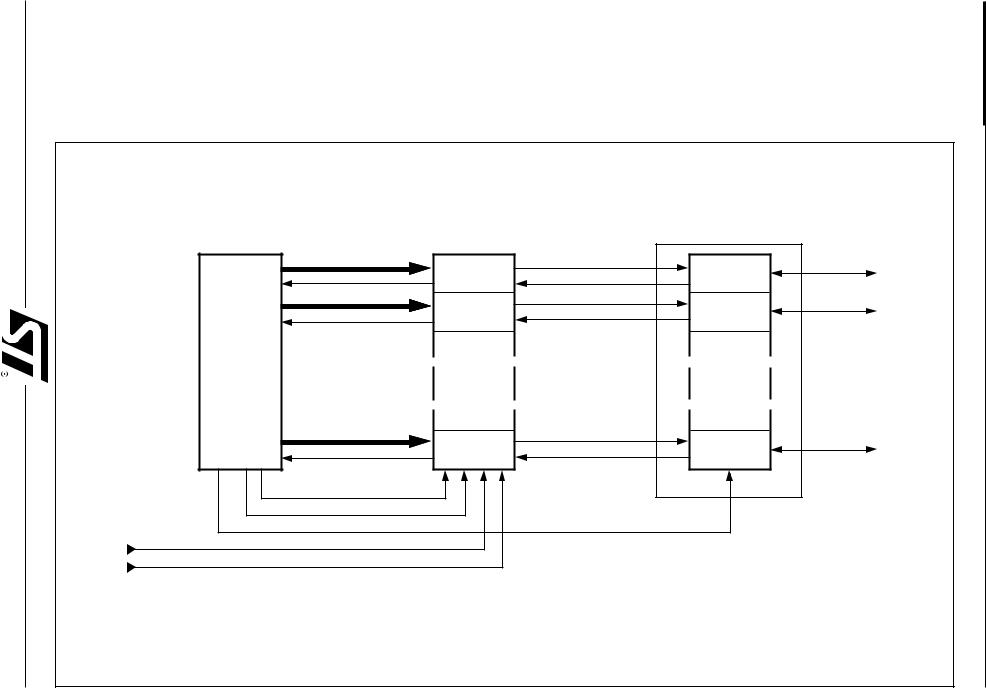
18 |
|
|
).(cont |
Architecture |
PSD5XX The |
Family PSD5XX |
|
|
|
|
|
.6a Figure |
|
|
|
|
PORT A I/O CELLS |
|
PA |
|
|
PA MACROCELL |
|
|
Macrocell |
|
|
|
|
|
|
|
||
PT [2:0] |
|
MACRO. OUT |
|
|
|
|
PA0 |
MC0 |
PA0 – INPUT |
PA0 |
|
|
|
PT [2:0] |
|
MACRO. OUT |
|
|
|
|
|
MC1 |
PA1– INPUT |
PA1 |
|
|
|
PA1 |
|
Block |
|
|||
|
|
|
|
|
|
|
AND ARRAY |
|
|
|
|
Diagram |
|
|
|
|
|
|
|
|
PT [2:0] |
|
MACRO. OUT |
|
|
|
|
|
|
|
|
|
|
|
PA7 |
MC7 |
PA7– INPUT |
PA7 |
|
|
|
PA.PR |
|
|
|
|
|
|
PA.RE |
|
|
|
|
|
|
PA.OE |
|
|
|
|
|
|
CLKIN |
|
|
|
|
|
|
MACRO – RST |
|
|
|
|
|
|

|
|
).(cont |
Architecture |
PSD5XX The |
ZPLD |
|
|
|
Figure |
|
|
|
.7 |
|
BUS |
PA .OE |
|
|
|
|
PT |
|
|
PA |
|
|
|
|
|
|
PA . PR |
|
|
Macrocell |
|
PT |
COMB/REG |
|
|
|
|
|
||
|
PT0 |
SELECT |
|
|
|
|
|
||
|
PT |
|
|
|
|
PT1 |
I/O PIN |
|
|
|
|
|
||
|
PT |
|
|
|
|
PAi |
|
|
|
|
|
|
|
|
|
PT2 |
MACRO . OUT |
|
|
|
PT |
MUX |
|
|
|
|
PR |
|
|
|
D |
Q |
|
|
|
AND |
|
|
|
|
ARRAY |
|
|
|
|
POLARITY |
PORT A |
|
|
|
|
|
|
|
|
SELECT |
C |
|
|
|
PA .RE |
|
|
|
|
PT |
|
|
|
|
|
MUX |
|
|
|
|
PAi – INPUT |
|
|
|
PAi |
|
|
|
|
MACRO – RST |
PLD– IN |
|
|
|
|
SELECT |
|
PSD5XX |
|
CLKIN |
|
|
|
|
|
INTERNAL |
|
|
|
|
ADDRESS/DATA |
|
|
|
|
|
Family |
|
19 |
NOTE: i = 7 TO 0 |
BUS |
|
|
|
|
|

PSD5XX Family
The PSD5XX
Architecture
(cont.)
9.1.2.2 Port B Macrocell Structure
Figure 8 shows the PB Macrocell block, which consists of 8 identical macrocells. Each macrocell output can be connected to its own I/O pin on Port B. The two inputs, CLKIN and MACRO-RST, are used as clock and clear inputs to all the macrocells. The CLKIN comes directly from the CLKIN input pin. The MACRO-RST is the same as the Reset input pin except it is user configurable.
The circuit of a PB Macrocell is shown in Figure 9. There are 10 product terms from the GPLD’s AND ARRAY as inputs to the macrocell. Users can select the polarity of the output, and configure the macrocell to operate as:
Registered Output
Select output from D flip flop.
Combinatorial Output
Select output from OR gate.
GPLD Input
Use Port B pin as dedicated input.
GPLD Output
Use Port B pin as dedicated output.
GPLD I/O
Use Port B pin as bidirectional pin.
Macrocell Feedback
Register feedback for state machine implementations or expander feedback from the combinatorial output, to possibly expand the number of product terms available to another macrocell.
In case of "Buried Feedback", where the output of the macrocell is not connected to a Port B pin, Port B can be configured to perform other user defined I/O functions.
Each D flip flop in the macrocells has its own dedicated asynchronous clear, preset and clock input. The signals are defined as follow:
PRESET
Active only if defined by a product term (PBx.PR)
CLEAR
Two selectable inputs: Reset input or user defined product term (PBx.RE)
CLK
Two selectable inputs – CLKIN input or user defined product term (PBx.CLK).
The macrocell is operated in Synchronous Mode if the clock input is CLKIN, and is in Asynchronous Mode if the clock is a product-term clock defined by the user.
20
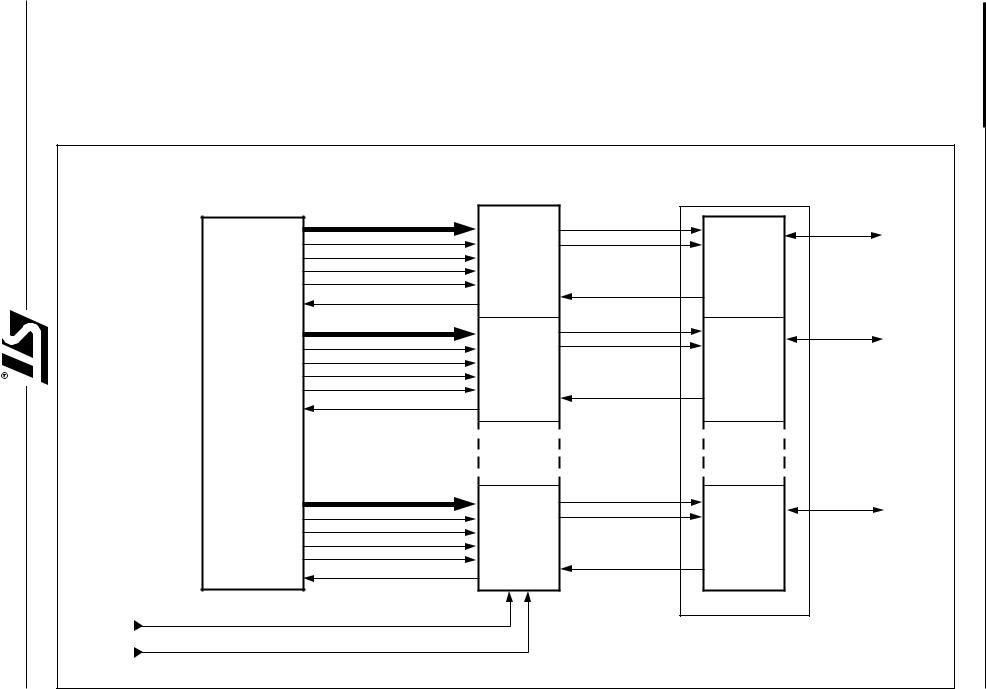
|
|
|
).(cont |
Architecture |
PSD5XX The |
|
|
PB MACROCELL |
PORT B I/O CELLS |
|
.8 Figure |
|
PTB0 – [0 . . 5] |
|
MACRO .OUT |
|
PB |
|
PB0 .PR |
|
PB0 .OE |
|
Macrocell |
|
PB0 .RE |
|
|
|
|
|
PB0 .OE |
MC0 |
PB0 |
|
|
|
PB0 .CLK |
|
PB0 – INPUT |
|
|
|
PB0 |
|
|
||
|
|
|
|
||
|
|
|
|
Block |
|
|
PTB1 – [0 . . 5] |
|
MACRO .OUT |
|
|
|
PB1 .PR |
|
PB1 .OE |
|
|
|
|
|
Diagram |
||
|
|
|
|
||
|
PB1 .RE |
|
|
|
|
|
PB1 .OE |
MC1 |
PB1 |
|
|
AND ARRAY |
PB1 .CLK |
|
|||
|
PB1– INPUT |
|
|||
|
PB1 |
|
|
||
|
|
|
|
||
|
|
|
|
|
|
|
PTB7 – [0 . . 5] |
|
MACRO .OUT |
|
|
|
PB7 .PR |
|
PB7 .OE |
|
|
|
PB7 .RE |
MC7 |
PB7 |
|
|
|
PB7 .OE |
|
|
||
|
PB7 .CLK |
|
PB7– INPUT |
|
|
|
PB7 |
|
|
|
|
|
|
|
|
|
|
|
CLKIN |
|
|
|
PSD5XX |
|
MACRO – RST |
|
|
|
|
|
|
|
|
Family |
|
21 |
|
|
|
|
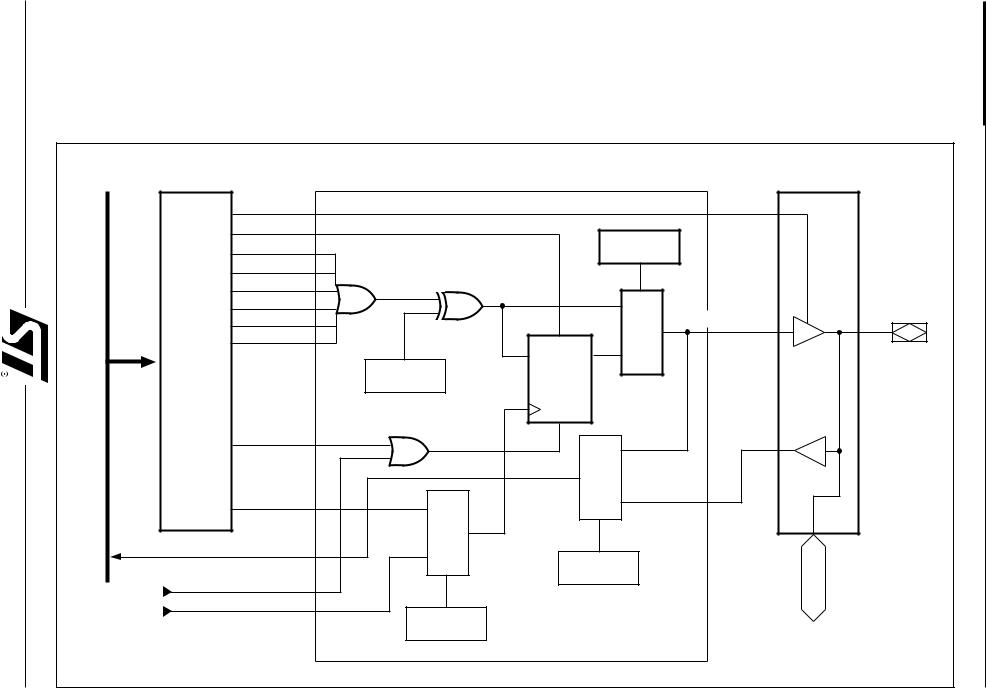
22 |
|
|
|
).(cont |
Architecture |
PSD5XX The |
Family PSD5XX |
ZPLD |
|
|
|
|
|
Figure |
|
BUS |
|
|
|
|
|
|
|
|
|
|
|
|
.9 |
|
|
|
PBi .OE |
|
|
|
|
|
|
PT |
|
|
|
|
PB |
|
|
|
|
|
|
|
|
||
|
PBi .PR |
|
|
|
|
|
|
PT |
|
|
|
|
Macrocell |
|
|
|
|
COMB /REG |
|
|
|
||
|
PT0 |
|
|
|
|
||
PT |
|
SELECT |
|
|
|
||
|
|
|
|
|
|||
PT |
PT1 |
|
|
|
|
|
|
PT2 |
|
|
|
|
|
||
PT |
|
|
|
|
|
||
PT3 |
|
|
I/O PIN |
|
|
||
PT |
|
|
|
|
|
||
PT4 |
|
MACRO . OUT |
PBi |
|
|
|
|
|
|
|
|
|
|||
PT |
|
|
|
|
|
||
PT5 |
|
MUX |
|
|
|
|
|
PT |
|
|
|
|
|
||
|
|
PR |
|
|
|
|
|
|
|
D |
Q |
|
|
|
|
AND |
|
POLARITY |
|
|
|
|
|
|
SELECT |
|
|
|
|
|
|
ARRAY |
|
|
|
|
|
|
|
|
|
|
PORT B |
|
|
|
|
|
|
|
|
|
|
|
|
|
|
|
C |
|
|
|
|
PT |
PBi .RE |
|
|
|
|
|
|
|
|
|
|
|
|
|
|
|
|
|
MUX |
|
|
|
|
|
PBi .CLK |
|
PBi – INPUT |
|
|
|
|
PT |
|
|
|
|
|
|
|
|
|
|
|
|
|
|
|
|
|
MUX |
|
|
|
|
|
PBi |
|
|
|
|
|
|
|
|
|
|
PLD – IN |
|
|
|
|
MACRO – RST |
|
SELECT |
|
|
|
|
|
|
|
|
|
|
|
||
CLKIN |
|
|
|
|
|
|
|
|
|
CLK |
|
|
|
|
|
|
|
SELECT |
|
INTERNAL |
|
|
|
|
|
|
|
|
|
|
|
NOTE: i = 7 TO 0 |
|
|
ADDRESS/DATA |
|
|
|
|
|
|
BUS |
|
|
|
||

PSD5XX Family
The PSD5XX
Architecture
(cont.)
9.1.2.3 Port E Macrocell Structure
Figure 10 shows the PE Macrocell block, which consists of 8 identical macrocells. Each macrocell output can be connected to its own I/O pin on Port E. There are 3 user programmable global product terms output from the GPLD’s AND ARRAY which are shared by all the macrocells in Port E:
PE.OE
Enable or tri-state Port PE output pins
PE.PR
Preset D flip flop in the macrocells
PE.RE
Reset/Clear D flip flop in the macrocells
Two other inputs, CLKIN and MACRO-RST, are used as clock and clear inputs to the D flip flop. The CLKIN comes directly from the CLKIN input pin. The MACRO-RST is the same as the Reset input pin except it is user configurable.
The circuit of a PE Macrocell is shown in Figure 11. There are 4 product terms from the GPLD’s AND ARRAY as input to the macrocell. Users can select the polarity of the output and configure the macrocell to operate as:
Registered Output
Select output from D flip flop
Combinatorial Output
Select output from OR gate
GPLD Input
Use Port E pin as dedicated input
GPLD Output
Use Port E pin as dedicated output
GPLD I/O
Use Port E pin as bidirectional pin
Macrocell Feedback
Register feedback for state machine implementations or expander feedback from the combinatorial output, to possibly expand the number of product terms available to another macrocell.
In case of "Buried Feedback", where the output of the macrocell is not connected to Port E pin, Port E can be configured to perform other user defined I/O functions. If pins PE0 and PE1 are used as bus control signal inputs (ALE, PSEN/BHE), the corresponding macrocells' feedbacks are disabled. The bus control signals are connected to the ZPLD Input Bus.
The two global product terms assigned for asynchronous clear (PE.RE) and preset (PE.PR) are mainly for proper PE Macrocell initialization.
The macrocell flip-flop can also be cleared during reset by MACRO-RST, if such an option is chosen. The clock source is always the input clock CLKIN.
23
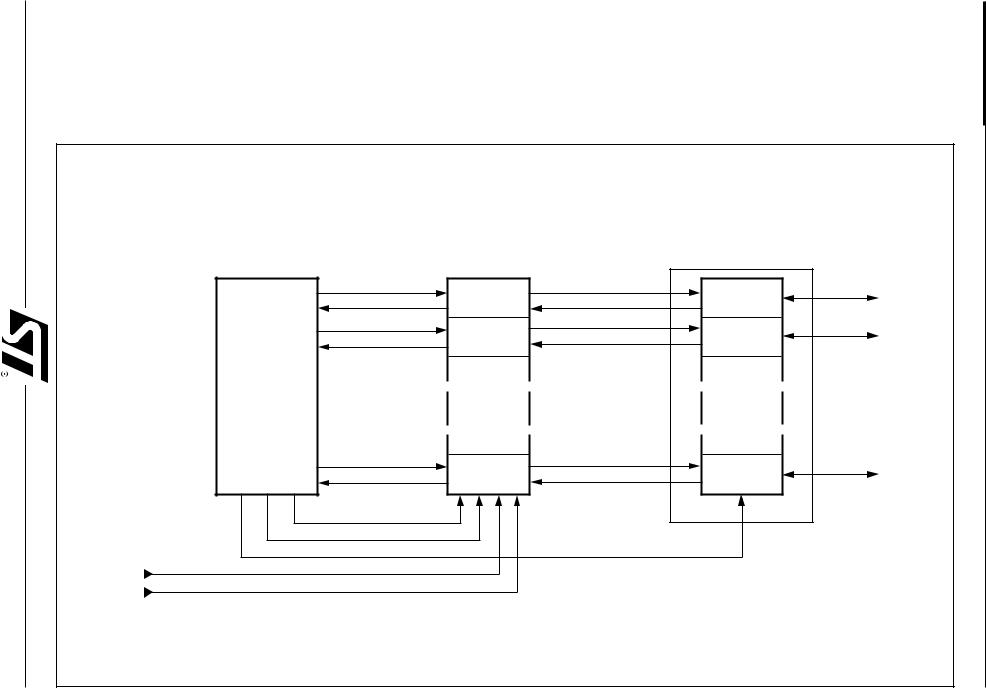
24 |
|
|
).(cont |
Architecture |
PSD5XX The |
Family PSD5XX |
|
|
|
|
|
.10 Figure |
|
|
|
|
|
|
PE |
|
|
PE MACROCELL |
|
PORT E I/O CELLS |
|
Macrocell |
|
|
|
|
|
|
||
PT |
|
MACRO .OUT |
|
|
|
|
PE0 |
MC0 |
PE0 – INPUT |
PE0 |
|
|
|
PT |
|
MACRO .OUT |
|
|
Block |
|
PE1 |
MC1 |
PE1 – INPUT |
PE1 |
|
|
|
AND ARRAY |
|
|
|
|
Diagram |
|
|
|
|
|
|
|
|
PT |
|
MACRO .OUT |
|
|
|
|
|
|
|
|
|
|
|
PE7 |
MC7 |
PE7– INPUT |
PE 7 |
|
|
|
PE .PR |
|
|
|
|
|
|
PE .RE |
|
|
|
|
|
|
PE .OE |
|
|
|
|
|
|
CLKIN |
|
|
|
|
|
|
MACRO – RST |
|
|
|
|
|
|

|
|
|
|
).(cont |
Architecture |
PSD5XX The |
|
|
|
|
|
|
Figure |
ZPLD |
|
|
|
|
|
.11 |
BUS |
|
|
|
|
|
|
PE .OE |
|
|
|
|
|
PE |
PT |
|
|
|
|
|
|
|
|
|
COMB/REG |
|
|
Macrocell |
PE .PR |
|
|
SELECT |
|
|
|
PT |
|
|
|
|
|
|
PT |
|
|
|
I/O PIN |
|
|
PT |
|
|
|
|
||
|
|
|
MACRO .OUT |
PEi |
|
|
|
|
|
|
|
||
|
|
|
|
|
|
|
|
|
|
MUX |
|
|
|
|
|
|
PR |
|
|
|
AND |
POLARITY |
D |
Q |
|
|
|
ARRAY |
SELECT |
|
|
|
|
|
|
|
|
|
PORT E |
|
|
|
|
|
C |
|
|
|
PE .RE |
|
|
|
|
|
|
PT |
|
|
|
|
|
|
|
|
|
MUX |
|
|
|
|
|
|
PEi – INPUT |
|
|
|
PEi |
|
|
|
|
|
|
MACRO – RST |
|
|
PLD– IN |
|
|
|
|
|
SELECT |
|
|
|
|
|
|
|
|
|
|
|
CLKIN |
|
|
|
|
|
PSD5XX |
|
|
|
|
INTERNAL |
|
|
NOTE: i = 7 to 0 |
|
|
|
ADDRESS/DATA |
|
|
|
|
|
|
Family |
||
|
|
|
BUS |
|
||
|
|
|
|
|
||
25 |
|
|
|
|
|

PSD5XX Family
The PSD5XX
Architecture
(cont.)
9.1.3 The PPLD
The Peripheral Programmable Logic Device (PPLD) provides a powerful mechanism for the user to control the operations of the Counter/Timer and Interrupt Controller. Figure 12 is the PPLD block diagram. There are six Peripheral Macrocells, four are dedicated to the Counter/Timer, and two to the Interrupt Controller.
The outputs from the four Peripheral Macrocells, MC2TMR[3:0], are used as load/store/enable inputs to the Counter/Timer (multiplexed with pin inputs TIMER[3:0] _IN). The remaining two macrocell outputs (MC2INT[6:7] ), together with two other product terms (PT2INT4, PT2INT5), can generate up to 4 user defined interrupts to the Interrupt Controller. The watch-dog output of the Timer (WDOG2PLD) and Interrupt Controller (INTR2PLD) are available as inputs to the ZPLD’s AND ARRAY.
The structure of a Peripheral Macrocell is shown in Figure 13. The cell has two product term inputs from the AND ARRAY. The user can select the registered or combinatorial output of the macrocell, as well as the output polarity. The registers are clocked by the CLKIN clock, and are cleared by the RESET input during power up.
9.1.4 The ZPLD Power Management
The ZPLD implements a Zero Power Mode, which provides considerable power savings for low to medium frequency operations. To enable this feature, the ZPLD Turbo bit in the Power Management Mode Register 0 (PMMR0) has to be turned off.
If none of the 61 inputs to the ZPLD are switching for a time period of 70ns, the ZPLD puts itself into Zero Power Mode and the current consumption is minimal. The ZPLD will resume normal operation as soon as one or more of the inputs change state.
Two other features of the ZPLD provide additional power savings:
1.Clock Disable:
Users can disable the clock input to the ZPLD and/or macrocells, thereby reducing AC power consumption.
2.Product Term Disable:
Unused product terms in the ZPLD are disabled by the PSDsoft Software automatically for further power savings.
The ZPLD power configuration is described in the Power Management Unit section.
26
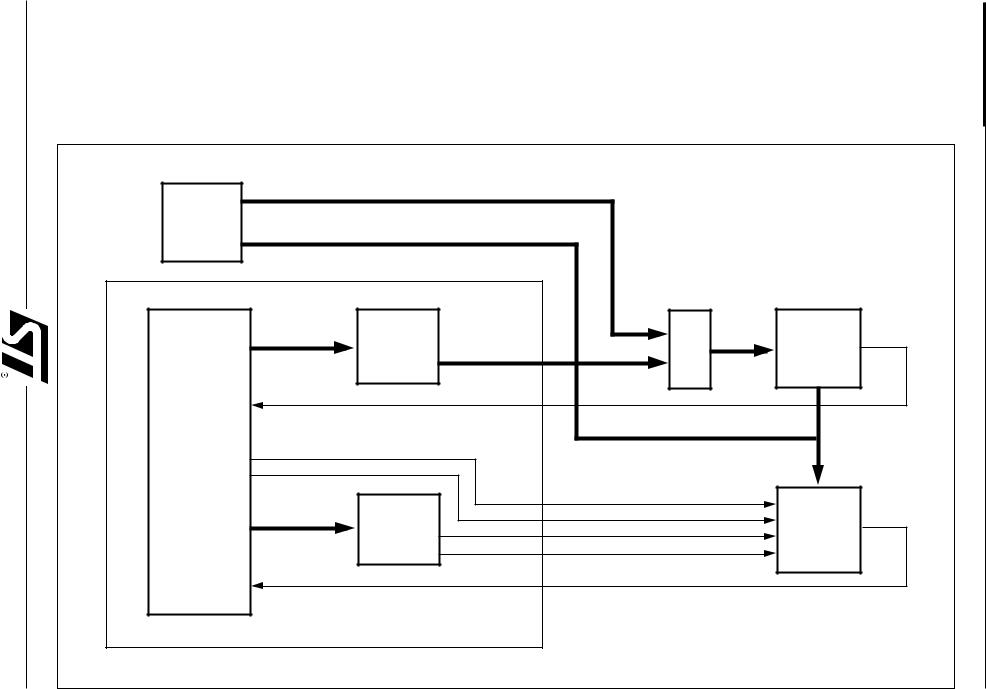
|
|
|
|
|
).(cont |
Architecture |
PSD5XX The |
|
|
TIMER [3 : 0] |
– IN |
|
|
|
Figure |
|
|
|
|
|
.12 |
||
|
|
|
|
|
|
|
|
PORT |
|
TC[3 : 0] |
|
|
|
|
BlockPPLD |
E |
|
|
|
|
|
||
|
|
|
|
|
|
||
|
PT (8) |
MACROCELLS |
MC2TMR |
MUX |
COUNTER/ |
|
Diagram |
|
|
(4) |
[3 : 0] |
TIMER |
|
|
|
|
|
WDOG2PLD |
|
|
|
|
|
|
|
|
|
|
TC[3 : 0] |
|
|
AND ARRAY |
PT |
|
|
|
|
|
|
PT |
|
|
|
|
|
|
|
|
|
|
|
|
|
|
|
|
|
|
|
PT2INT4 |
|
|
|
|
PT (4 ) |
MACROCELLS |
|
PT2INT5 |
INTERRUPT |
|
|
|
|
MC2INT6 |
|
|
|||
|
|
|
|
|
|||
|
|
(2) |
|
CONTROLLER |
|
|
|
|
|
|
MC2INT7 |
|
|
||
|
|
|
|
|
|
|
|
|
|
INTR2PLD |
|
|
|
|
|
27 |
|
|
|
|
|
|
Family PSD5XX |
